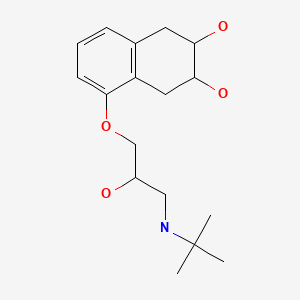CASRN: 42200-33-9

Drug Levels and Effects
Summary of Use during Lactation
Because of its relatively extensive excretion into breastmilk and its renal excretion, other beta-adrenergic blocking drugs are preferred to nadolol, especially while nursing a newborn or preterm infant.
Drug Levels
The excretion of beta-adrenergic blocking drugs into breastmilk is largely determined by their protein binding. Those with low binding are more extensively excreted into breastmilk.[1] Accumulation of the drugs in the infant is related to the fraction excreted in urine. With 25% protein binding, 70% renal excretion and long half-life, nadolol presents a high risk for accumulation in infants, especially neonates. It is estimated that a fully breastfed infant would receive about 5.1% of the maternal weight-adjusted dosage of nadolol.[2]
Maternal Levels. One mother received nadolol 20 mg daily during gestation for hypertension, with the last dose taken 20 hours before delivery. A single sample of breastmilk obtained 38 hours postpartum (58 hours after the last dose) was 146 mcg/L.[3]
After oral doses of 80 mg daily in 12 women, peak nadolol levels occurred in milk at an average of 6 hours after the dose, compared to peak serum levels at 2.7 hours. Serum and milk half-lives were both about 22 hours. Steady-state milk levels occurred after 3 days of therapy; peak milk levels averaged 443 mcg/L and the mean milk levels averaged 357 mcg/L. None of the infants were breastfed.[4,5]
Infant Levels. Relevant published information was not found as of the revision date.
Effects in Breastfed Infants
Relevant published information on nadolol was not found as of the revision date. A study of mothers taking beta-blockers during nursing found a numerically, but not statistically significant increased number of adverse reactions in those taking any beta-blocker. Although the ages of infants were matched to control infants, the ages of the affected infants were not stated. None of the mothers were taking nadolol.[6]
Effects on Lactation and Breastmilk
Relevant published information on the effects of beta-blockade or nadolol during normal lactation was not found as of the revision date. A study in 6 patients with hyperprolactinemia and galactorrhea found no changes in serum prolactin levels following beta-adrenergic blockade with propranolol.[7]
Alternate Drugs to Consider
References
- 1.
- Riant P, Urien S, Albengres E, et al. High plasma protein binding as a parameter in the selection of betablockers for lactating women. Biochem Pharmacol. 1986;35:4579–81. [PubMed: 2878668]
- 2.
- Atkinson HC, Begg EJ, Darlow BA. Drugs in human milk: Clinical pharmacokinetic considerations. Clin Pharmacokinet. 1988;14:217–40. [PubMed: 3292101]
- 3.
- Fox RE, Marx C, Stark AR. Neonatal effects of maternal nadolol therapy. Am J Obstet Gynecol. 1985;152:1045–6. [PubMed: 4025452]
- 4.
- Devlin RG, Duchin KL, Fleiss PM. Nadolol in human serum and breast milk. Br J Clin Pharmacol. 1981;12:393–6. [PMC free article: PMC1401819] [PubMed: 6117304]
- 5.
- Devlin RG, Fleiss PM. Nadolol excretion in human milk. Clin Pharmacol Ther 1981;29:240. Abstract. doi: 10.1038/clpt.1981.37. [CrossRef]
- 6.
- Ho TK, Moretti ME, Schaeffer JK, et al. Maternal beta-blocker usage and breast feeding in the neonate. Pediatr Res. 1999;45(4, pt. 2):67A–Abstract 385. [CrossRef]
- 7.
- Board JA, Fierro RJ, Wasserman AJ, et al. Effects of alpha- and beta-adrenergic blocking agents on serum prolactin levels in women with hyperprolactinemia and galactorrhea. Am J Obstet Gynecol. 1977;127:285–7. [PubMed: 556882]
Substance Identification
Substance Name
Nadolol
CAS Registry Number
42200-33-9
Drug Class
Breast Feeding
Lactation
Antihypertensive Agents
Adrenergic Beta-Antagonists
Antiarrhythmics
Disclaimer: Information presented in this database is not meant as a substitute for professional judgment. You should consult your healthcare provider for breastfeeding advice related to your particular situation. The U.S. government does not warrant or assume any liability or responsibility for the accuracy or completeness of the information on this Site.
Publication Details
Publication History
Last Revision: February 23, 2021.
Copyright
Attribution Statement: LactMed is a registered trademark of the U.S. Department of Health and Human Services.
Publisher
National Institute of Child Health and Human Development, Bethesda (MD)
NLM Citation
Drugs and Lactation Database (LactMed®) [Internet]. Bethesda (MD): National Institute of Child Health and Human Development; 2006-. Nadolol. [Updated 2021 Feb 23].